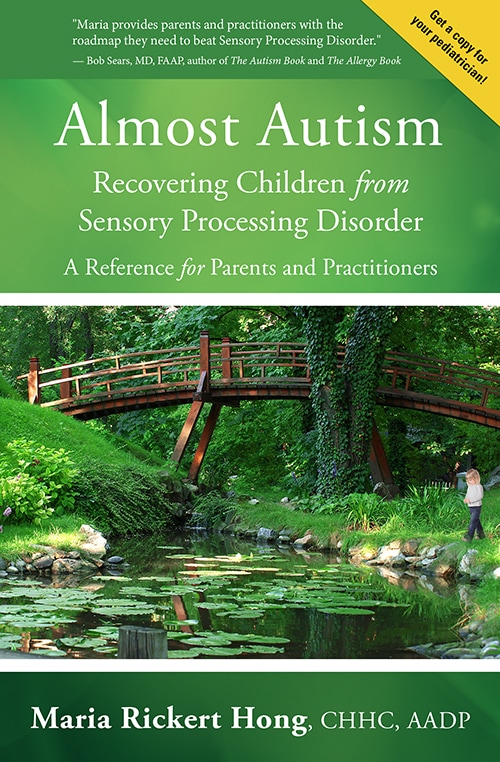After delving into the literature, and speaking with some occupational therapists (OTs), Carol learned that there was a name for these behaviors: “Sensory Integration (SI) Dysfunction.” The term was coined by the brilliant A. Jean Ayres, PhD, way back in 1955, and shared with the world in 1972. Recognizing then, what parents and teachers know now, Carol wrote the first down-to-earth explanation of this complex theory.
What’s in the Third Edition
Now, almost 25 years later, Carol has updated her guidebook to help a new generation of caregivers and educators discover and understand what could be a missing piece of their children’s complicated puzzle. Now we have new terminology, information about “look-alike” conditions such as autism, and a refreshed approach to diagnosis and treatment. The explanations of differences in sensory modulation, sensory discrimination, and sensory-based motor abilities provide needed clarification of what is now called Sensory Processing Disorder, or SPD.
First, the terminology. SPD. What that “D” stands for depends upon who you ask. Initially, it was D for Dysfunction. Then Disorder. How about Delays? Deficits? Disabilities? Difficulties? Dimensions? Differences? All will do. Carol prefers “Differences,” because that term indicates that each person processes sensations in a unique way.
And how about the middle letter? Is it an “I” or a “P.” The American Occupational Therapy Association prefers a “P.” Most OTs, and Carol, now call it SPD, instead of SID, to distinguish it from SIDS, the acronym for “sudden infant death syndrome,” an altogether different problem.
What Is Sensory Processing Disorder?
So, now that we have gotten the terminology out of the way, let’s delve into the guts of this updated classic. Is your child someone who LOVES being touched or HATES it? Learn all about the TACTILE sense. Maybe you’ve never heard of the VESTIBULAR sense. Also known as the balance sense, Carol describes how it affects almost everything we do, including our language output, our affect, our vision, and more. And, of course, MY favorite, VISION. SO so misunderstood, and important in all aspects of learning and behavior at school, home, and everywhere we go.
What is SPD? Are the behaviors your child is demonstrating REALLY SPD, or could they be something else? Maybe you need to look into a differential diagnosis. Years ago, I produced a chart that shows how the symptoms of ADHD, the acronym for Attention Deficit Hyperactivity Disorder, are also present in kids with SPD, allergies, vision issues, and even in “typical” children under age seven. I am honored that Carol has reproduced this chart in the third edition of The Out-of-Sync Child.
Conclusion
Carol Kranowitz was a pioneer in translating the world of SPD to teachers and parents. She truly put the term “out-of-sync” on the map. The third edition of this book maintains a good balance between pathologizing and recognizing individual differences.
Even if you already have the original of The Out-of-Sync Child or the second version, you need this one, too. It will bring you up to date with some new definitions and Carol’s creative ideas for activities. And, while you’re at it, pick up an extra copy for a special teacher or therapist. And check out her other books, some written with perceptual motor therapist, Joye Newman: The Out-of-Sync Child Has Fun, Growing an In-Sync Child, and The Out-of-Sync Child Grows Up. Let’s get IN SYNC together!
About Carol Stock Kranowitz MA
As a music, movement and drama teacher for 25 years (1976-2001), Carol observed many out-of-sync preschoolers. To help them become more competent in their work and play, she began to study sensory processing and sensory integration (“SI”) theory.
She learned to help identify her young students’ needs and to steer them into early intervention.
In writings and workshops, she explains to parents, educators, and other early childhood professionals how sensory issues play out – and provides fun and functional techniques for addressing them at home and school.

She is best-known for her book, The Out-of-Sync Child, which has sold about 1 million copies. You can find out more about her at Out-of-Sync-Child.com
Still Looking for Answers?
Visit the Epidemic Answers Practitioner Directory to find a practitioner near you.
Join us inside our online membership community for parents, Healing Together, where you’ll find even more healing resources, expert guidance, and a community to support you every step of your child’s healing journey.
Resources
Books
Biel, Lindsey. Raising a Sensory Smart Child: The Definitive Handbook for Helping Your Child with Sensory Processing Issues. Revised Edition, 2009
Hong, Maria Rickert. Almost Autism: Recovering Children from Sensory Processing Disorder, A Reference for Parents and Practitioners. 2014.
Kranowitz, Carol. The Out-of-Sync Child: Recognizing and Coping with Sensory Processing Disorder. Penguin Random House, revised edition 2022.
Websites
More To Explore
Join our email list to get free healing resources delivered right to your inbox.
Join our community

This information is not a substitute for medical advice, treatment, diagnosis, or consultation with a medical professional. It is intended for general informational purposes only and should not be relied on to make determinations related to treatment of a medical condition. Epidemic Answers has not verified and does not guarantee the accuracy of the information provided in this document.
© Copyright 2013-2024 Epidemic Answers. All rights reserved. Privacy Policy | Terms of Service | Disclaimer | Website by fuseStarter




